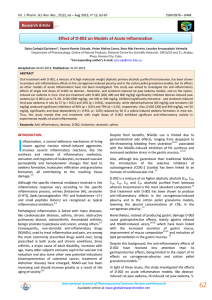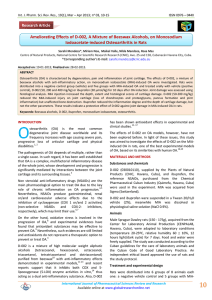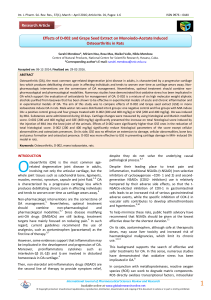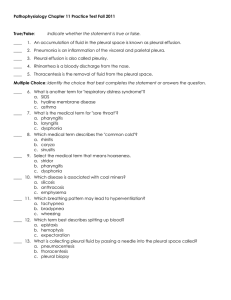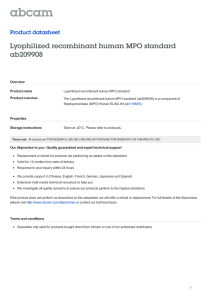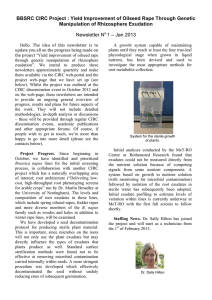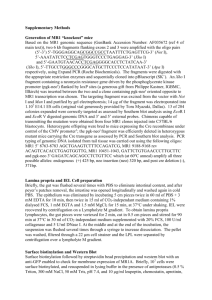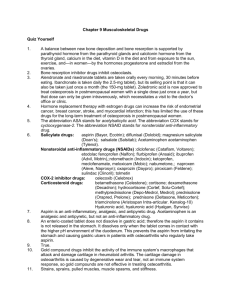Document 13309376
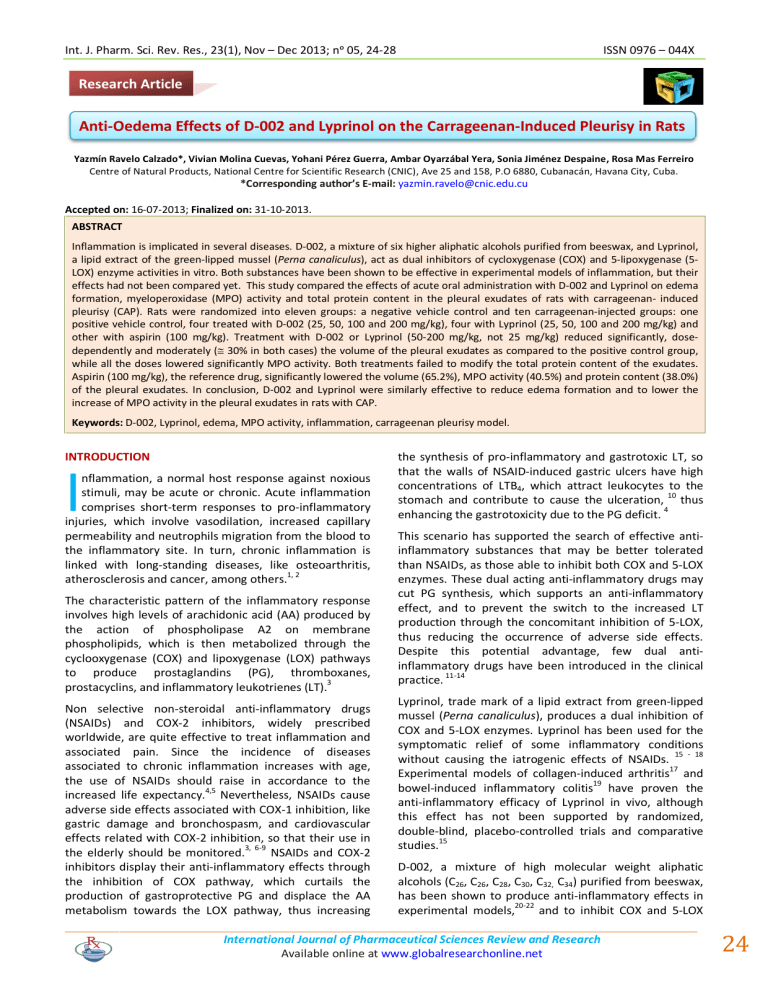
Int. J. Pharm. Sci. Rev. Res., 23(1), Nov – Dec 2013; n ᵒ 05, 24-28 ISSN 0976 – 044X
Research Article
Anti-Oedema Effects of D-002 and Lyprinol on the Carrageenan-Induced Pleurisy in Rats
Yazmín Ravelo Calzado*, Vivian Molina Cuevas, Yohani Pérez Guerra, Ambar Oyarzábal Yera, Sonia Jiménez Despaine, Rosa Mas Ferreiro
Centre of Natural Products, National Centre for Scientific Research (CNIC), Ave 25 and 158, P.O 6880, Cubanacán, Havana City, Cuba.
*Corresponding author’s E-mail: yazmin.ravelo@cnic.edu.cu
Accepted on: 16-07-2013; Finalized on: 31-10-2013.
ABSTRACT
Inflammation is implicated in several diseases. D-002, a mixture of six higher aliphatic alcohols purified from beeswax, and Lyprinol, a lipid extract of the green-lipped mussel (Perna canaliculus), act as dual inhibitors of cycloxygenase (COX) and 5-lipoxygenase (5-
LOX) enzyme activities in vitro. Both substances have been shown to be effective in experimental models of inflammation, but their effects had not been compared yet. This study compared the effects of acute oral administration with D-002 and Lyprinol on edema formation, myeloperoxidase (MPO) activity and total protein content in the pleural exudates of rats with carrageenan- induced pleurisy (CAP). Rats were randomized into eleven groups: a negative vehicle control and ten carrageenan-injected groups: one positive vehicle control, four treated with D-002 (25, 50, 100 and 200 mg/kg), four with Lyprinol (25, 50, 100 and 200 mg/kg) and other with aspirin (100 mg/kg). Treatment with D-002 or Lyprinol (50-200 mg/kg, not 25 mg/kg) reduced significantly, dosedependently and moderately ( 30% in both cases) the volume of the pleural exudates as compared to the positive control group, while all the doses lowered significantly MPO activity. Both treatments failed to modify the total protein content of the exudates.
Aspirin (100 mg/kg), the reference drug, significantly lowered the volume (65.2%), MPO activity (40.5%) and protein content (38.0%) of the pleural exudates. In conclusion, D-002 and Lyprinol were similarly effective to reduce edema formation and to lower the increase of MPO activity in the pleural exudates in rats with CAP.
Keywords: D-002, Lyprinol, edema, MPO activity, inflammation, carrageenan pleurisy model.
INTRODUCTION
I nflammation, a normal host response against noxious stimuli, may be acute or chronic. Acute inflammation comprises short-term responses to pro-inflammatory injuries, which involve vasodilation, increased capillary permeability and neutrophils migration from the blood to the inflammatory site. In turn, chronic inflammation is linked with long-standing diseases, like osteoarthritis, atherosclerosis and cancer, among others.
1, 2
The characteristic pattern of the inflammatory response involves high levels of arachidonic acid (AA) produced by the action of phospholipase A2 on membrane phospholipids, which is then metabolized through the cyclooxygenase (COX) and lipoxygenase (LOX) pathways to produce prostaglandins (PG), thromboxanes, prostacyclins, and inflammatory leukotrienes (LT).
3 the synthesis of pro-inflammatory and gastrotoxic LT, so that the walls of NSAID-induced gastric ulcers have high concentrations of LTB
4
, which attract leukocytes to the stomach and contribute to cause the ulceration,
10 thus enhancing the gastrotoxicity due to the PG deficit.
4
This scenario has supported the search of effective antiinflammatory substances that may be better tolerated than NSAIDs, as those able to inhibit both COX and 5-LOX enzymes. These dual acting anti-inflammatory drugs may cut PG synthesis, which supports an anti-inflammatory effect, and to prevent the switch to the increased LT production through the concomitant inhibition of 5-LOX, thus reducing the occurrence of adverse side effects.
Despite this potential advantage, few dual antiinflammatory drugs have been introduced in the clinical practice.
11-14
Non selective non-steroidal anti-inflammatory drugs
(NSAIDs) and COX-2 inhibitors, widely prescribed worldwide, are quite effective to treat inflammation and associated pain. Since the incidence of diseases associated to chronic inflammation increases with age, the use of NSAIDs should raise in accordance to the increased life expectancy.
4,5
Nevertheless, NSAIDs cause adverse side effects associated with COX-1 inhibition, like gastric damage and bronchospasm, and cardiovascular effects related with COX-2 inhibition, so that their use in the elderly should be monitored.
3, 6-9
NSAIDs and COX-2 inhibitors display their anti-inflammatory effects through the inhibition of COX pathway, which curtails the production of gastroprotective PG and displace the AA metabolism towards the LOX pathway, thus increasing
Lyprinol, trade mark of a lipid extract from green-lipped mussel (Perna canaliculus), produces a dual inhibition of
COX and 5-LOX enzymes. Lyprinol has been used for the symptomatic relief of some inflammatory conditions
15 - 18 without causing the iatrogenic effects of NSAIDs.
Experimental models of collagen-induced arthritis
17
and bowel-induced inflammatory colitis
19 have proven the anti-inflammatory efficacy of Lyprinol in vivo, although this effect has not been supported by randomized, double-blind, placebo-controlled trials and comparative studies.
15
D-002, a mixture of high molecular weight aliphatic alcohols (C
26
, C
26
, C
28
, C
30
, C
32,
C
34
) purified from beeswax, has been shown to produce anti-inflammatory effects in experimental models,
20-22 and to inhibit COX and 5-LOX
International Journal of Pharmaceutical Sciences Review and Research
Available online at www.globalresearchonline.net
24
Int. J. Pharm. Sci. Rev. Res., 23(1), Nov – Dec 2013; n ᵒ 05, 24-28 ISSN 0976 – 044X enzyme activities,
23
which supports its anti-inflammatory effects devoid of concomitant gastrotoxicity. Instead, D-
002 exhibits a gastroprotective action through a mechanism that involves the increase of gastric mucus secretion gastric mucosa.
In light of these issues, this study compared the antiinflammatory effects of D-002 and Lyprinol in rats with carrageenan-induced pleurisy, a classical model of acute inflammation.
MATERIALS AND METHODS
Animals
24, 25 and the reduction of oxidative stress in the
26, 27
28, 29
Male Sprague Dawley rats (200-250 g) were purchased to the National Center for Laboratory Animal Production
(CENPALAB, Havana, Cuba) and adapted for 7 days to the following experimental conditions: temperature (22-
23 o
C), relative humidity (55-60%) and 12 hours dark/light cycles. Food and water were freely supplied. The study was conducted in accordance with Cuban guidelines for the care of laboratory animals and the Cuban Code of
Good Laboratory Practice (GLP). An independent ethic board approved the study protocol and the use of the animals for this study.
100 and 200 mg/kg) and other with aspirin (100 mg/kg), the reference drug.
Induction of carrageenan-induced pleurisy (oedema)
Carrageenan-induced pleurisy was provoked 1 hour after the oral treatment. In brief, rats were anesthetized with sodium thiopental (40 mg/kg). Pleurisy was induced by intrapleural injection of 300 µL of 1% (w/v) carrageenan in saline dissolution. A specially adapted needle was introduced into the right side of the thoracic cavity of rats to inject the carrageenan suspension, and an equal volume of sterile saline was injected into the negative controls.
20
Five hours later, under an overdose of sodium thiopental, rats were sacrificed, their thoracic cavities were opened and pleural exudates were collected, homogenized in 1 mL of 3.15% sodium citrate and measured. Blood-contaminated exudates were discarded.
The percentage of oedema inhibition was calculated as follows: Inhibition (%) = 100 - TV/CV x 100 (%), where TV and CV represent the volume of pleural exudates in treated and control rats, respectively.
The significant reduction of the exudate volume as compared to the positive control groups was the primary efficacy variable of this study.
Administration and dosage
Assessment of myeloperoxidase (MPO) enzyme activity
The D-002 batch used in the study was supplied by the
Plants of Natural Products (National Centre for Scientific
Research, Havana City, Cuba). The batch composition, assessed with a validated gas chromatographic method,
Purity (total content of these alcohols) was 88.1 %.
30 was the following: 1-tetracosanol (7.1%), 1-hexacosanol
(11.2%), 1-octacosanol (13.8%), 1-triacontanol (31.4 %),
1-dotriacontanol (22.1%) and 1-tetratriacontanol (2.5%).
The lipid extract from green-lipped mussel (Perna
canaliculus) contains long-chain omega-3 polyunsaturated fatty acids (PUFAs) like eicosapentaenoic acid (14-20%), docosahexaenoic acid (11-17%) and other PUFA, palmitic acid 15-17%, cholesterol (about 30%) and sterols, sterol esters, triglycerides and polar lipids, as well.
31
Lyprinol soft-gel capsules (Blackmores, Australia, batch: 252918) used for the experiments contained 50 mg of the lipid extract from green-lipped mussel (Perna canaliculus) diluted in olive oil and Vitamin E. The content of the capsules was directly drawn with a syringe and used in the experiments.
MPO activity in the pleural cavity was measured in accordance with the Worthington enzyme manual.
32
Samples were sonicated for 10 seconds, freezing and thawing at 20 to 30 C three times, and centrifuged at 12
000 rpm for 25 minutes at 4 C. Then, 250 µL of the supernatant were mixed with 625 µL of 50 mmol/L phosphate buffer (pH 6) containing 0.167 mg/mL Odianisidine dihydrochloride and 125 µL of 0.0005% hydrogen peroxide. The absorbance changes at 460 nm were measured for two minutes in a spectrophotometer.
MPO activity data was expressed as units/g of tissue (U/g tissue). One unit of MPO activity was defined as that able to degrade 1 µmoL o f H
2
10, wherein
O
2
per minute at 25 C and was quantified as follows: U/g tissue = A min. x FV/8.3 x SV x
A min represents the absorbance variation,
FV the final volume in the cuvete and SV the volume of the added sample.
Total proteins
The concentration of total proteins was determinate by a modification of the Lowry method.
33
D-002 and Lyprinol were suspended in 2% Tween
65/water, respectively, while aspirin (from the Cuban
Pharmaceutical Industry, Havana, Cuba) was dissolved in acacia gum/water vehicle (10 mg/mL). All treatments were administered acutely by gastric gavage (5mL/kg).
Rats were randomized into eleven groups (8 rats per group): a negative control injected with saline dissolution in the pleural cavity and ten carrageenan-injected groups: one positive control (treated orally with the
Tween65/water vehicle), four groups treated with D-002
(25, 50, 100 and 200 mg/kg), four with Lyprinol (25, 50,
Statistical analyses
Comparisons among the groups were done with the
Kruskal-Wallis test, paired comparisons between treated and control groups with the Mann-Whitney U test.
Statistical significance was chosen for α = 0.05. Data were processed with the Statistics Software for Windows
(Release 6.1 Stat Soft Inc, Tulsa OK, USA). Dose/effect relationship was assessed by using lineal regression and correlation test using a Primer of Biostatistics program
International Journal of Pharmaceutical Sciences Review and Research
Available online at www.globalresearchonline.net
25
Int. J. Pharm. Sci. Rev. Res., 23(1), Nov – Dec 2013; n ᵒ 05, 24-28 ISSN 0976 – 044X
(Stanton A, Glantz; copyright (c) 1992, McGraw-Hill, Inc
Version 3.01).
RESULTS AND DISCUSSION marked reduction (65.2 %) of the pleural exudate volumes as compared to the positive control. The negative control group was not injected with carrageenan and received orally the vehicle only; all the other groups were injected with carrageenan and received orally the Table 1 summarizes the effects on the formation of pleural exudates. Carrageenan intrapleural injection increased the volumes of the pleural exudates of the positive controls as compared with those of the negative control group. This effect was significantly, dosedependently (p = 0.049, r = 0.951) and moderately ( 15 -
34%) attenuated by D-002 (25-200 mg/kg) as compared to the positive control group. The decrease produced with the lowest dose (25 mg/kg), however, was not significant. The effects of Lyprinol (25-200 mg/kg) were roughly similar to those of D-002, so that it significantly, dose-dependently (p = 0.002, r = 0.998) and moderately
( 32%) reduced the volumes of the exudates. In this case, however, 25 and 50 mg/kg did not produce significant reductions of pleural exudates, whereas 100 mg/kg seems to cause a maximal effect. Aspirin (100 respective treatments, such as vehicle (positive control),
D-002 at different concentrations or aspirin.
Positive controls exhibited greater values of MPO activity and protein concentrations in the pleural exudates than the negative controls (Table 2). D-002 (25-200 mg/kg) significantly inhibited MPO activity ( 15 – 34%) as compared to the positive control, in a manner that the inhibitions enhanced with the doses (p = 0.022, r = 0.978), but the ceiling effect was not found. In turn, Lyprinol (25-
200 mg/kg) significantly inhibited MPO activity ( 16 –
38%) versus the positive control, but once again the maximal effect was not reached. The effects of D-002 and
Lyprinol were statistically similar. Both treatments, however, failed to modify the protein content of the mg/kg), the reference drug, caused a significant and pleural exudates.
Table 1: Effects of D-002 and Lyprinol on the volume of pleural exudates
Treatment
Negative control
Positive control
D-002
D-002
D-002
D-002
Lyprinol
Lyprinol
Lyprinol
Lyprinol
Aspirin
Doses (mg/kg) Exudate volume (mL) I (%)
__
__
0.11 ± 0.05***
1.46 ± 0.11
__
__
25
50
100
1.26 ± 0.09
1.10 ± 0.05*
1.05 ± 0.07*
14.8
26.6
30.3
200 1.00 ± 0.06** 34.0
25
50
100
200
1.26 ± 0.13
1.22 ± 0.10
1.02 ± 0.08*
1.05 ± 0.26*
14.8
17.7
32.5
30.3
100 0.58 ± 0.08**++ 65.2
I (%): inhibition percent; *p 0.05, ** p 0.01 ***p 0.001 Comparison with the positive control; ++p 0.01 Comparisons with D-002 and Lyprinol groups (Mann Whitney U test)
Table 2: Effects of D-002 and Lyprinol on myeloperoxidase (MPO) and protein concentrations in pleural exudates
Treatment
Negative control
Positive control
D-002
D-002
D-002
D-002
Lyprinol
Lyprinol
Lyprinol
Lyprinol
Aspirin
Doses (mg/kg) MPO (U/g tissue)
__
__
2.44 ± 1.02**
66.56 ± 1.45
25
50
100
200
25
50
100
200
100
56.92 ± 1.37**
53.79 ± 0.92***
46.82 ± 1.26***
44.99 ± 1.09***
56.50 ± 1.38***
52.61 ± 1.04***
46.77 ± 2.43**
41.87 ± 1.93***
40.58 ± 3.66**
I (%)
__
__
15.0
19.9
30.8
33.6
15.7
21.8
30.9
38.5
40.5
Total protein (mg/mL)
7.49 ± 1.20***
23.33 ± 0.78
22.50 ± 1.30
22.21 ± 0.82
22.25 ± 1.03
22.10 ± 0.78
22.42 ± 1.26
22.65 ± 0.99
22.41 ± 0.92
22.41 ± 1.40
17,38 ± 0,60**
I (%): inhibition percent; ** p 0.01 ***p 0.001 Comparison with positive control (Mann Whitney U test)
I (%)
__
__
5.2
7.1
6.8
7.8
5.7
4.3
5.8
5.8
38.0
International Journal of Pharmaceutical Sciences Review and Research
Available online at www.globalresearchonline.net
26
Int. J. Pharm. Sci. Rev. Res., 23(1), Nov – Dec 2013; n ᵒ 05, 24-28 ISSN 0976 – 044X
Aspirin (100 mg/kg) significantly and moderately inhibited
MPO activity (40.5%) and reduced the protein content
(38.0%) of the pleural exudates. greater affinity for the former. In turn, D-002
Lyprinol
17, 19, 23 and
are dual COX/5-LOX inhibitors, more effective on 5-LOX than on COX enzyme activity. The increased protein content in the exudates induced by carrageenan depends mainly of the increase in vascular
This study demonstrates that oral treatment with D-002 and Lyprinol produces similar anti-edema effects in rats with carrageenan-induced pleurisy, a classical model of acute inflammation. permeability, which is highly dependent of COX-1, so the superior efficacy of aspirin is logical. In addition, recent data support that some lipoxins, lipid mediators that play
The intrapleural administration of carrageenan, a highmolecular-weight sulphated polysaccharide, leads to pleurisy, an inflammatory process characterized by an immediate recruitment of polymorphonuclear cells (PMN) and protein-rich fluid accumulation.
28, 29
In our study, carrageenan produced a marked oedema and increased the MPO activity and the protein content of the pleural exudates as compared to the negative controls, and all the carrageenan-induced changes were inhibited by aspirin, the reference drug, in agreement with the classical features reported for this model,
28, 29
all of which confers validity to the results obtained in our experimental conditions. a key role in the resolution of inflammation, are triggered by aspirin and exert a relevant role in the acute antiedematogenic action of aspirin in the carrageenaninduced pleurisy.
35
This study was not undertaken to reveal the mechanism(s) whereby D-002 and Lyprinol are effective on this model. Otherwise, based on the fact that both substances inhibit 5-LOX and COX activities,
17, 19, 23 we assumed and demonstrate that the anti-oedema effects of D-002 and Lyprinol on this model were similar.
The fact that all treatments displayed similar effects on
MPO activity, a good indicator of leucocyte recruitment, suggests that they exert similar influence on this process.
In our experiment, a significant and dose dependent reduction of the pleural exudate volume and MPO activity were noted with both treatments. In addition to be the first head to head comparison of the in vivo effects of D-
The superior efficacy of aspirin on oedema formation, however, clearly evidences that leukocyte recruitment is not the only process involved in the oedema formation, which comprises another targets.
35
002 and Lyprinol in an experimental model of inflammation, this study reports, for the first time, the effects of Lyprinol on this model, which were consistent with its mode of action.
17,19
On the other side, our results confirm the efficacy of D-002 (50, 100 and 200 mg/kg) on this model, in agreement with early reports,
20 but also
CONCLUSION
This study demonstrates that D-002 and Lyprinol orally administered to rats with carrageenan-induced pleurisy were similarly effective for lowering the oedema and for attenuating the increase of MPO activity without affecting includes the search of its effects on other targets (MPO activity and protein concentrations in pleural exudates), not tested before in this model. Nevertheless, evidences of the inhibitory effects of D-002 on MPO activity have been reported in other models of inflammation.
21, 22 the protein concentrations in the pleural exudates.
REFERENCES
These the potential anti-inflammatory effects of high molecular weight alcohols have been explored by other authors. In line with our data, a study found that the intraperitoneal injection of octacosanol (1 and 10 mg/kg)
(one of the main components of D-002) extracted from
1.
Mc Neill E, Channon K.M and Greaves D.R. Inflammatory cell recruitment in cardiovascular diseases: murine models and potential clinical applications. Clinical Science, 118, 2010, 641-655.
2.
Wierda R.J, S.B Geutskens, J.W, Jukema, P.H, Quax P.J, van den
Elsen J. Epigenetics in atherosclerosis and inflammation J. Cell.
Mol. Med, 14, 2010, 1225-1240. the leaves of Sabicea grisea displayed anti-inflammatory effects in the carrageenan-induced pleurisy. Octacosanol reduced the influx of total leukocytes into the pleural cavity triggered by carrageenan due to the inhibition of neutrophils recruitment, without alter mononuclear cells migration. The mechanism responsible for the antiinflammatory effects of the octacosanol was assumed to be associated, at least partly, with the inhibition of -2adrenergic transmission and pathways dependent on proinflammatory cytokines.
34
3.
Lamarque D. Pathogenesis of gastroduodenal lesions induced by non-steroidal anti-inflammatory drugs. Gastroenterol Clin. Biol, 28,
2004, 18-26.
4.
Scanzello CR, Moskowitz NK, et al. The post-NSAID era: what to use now for the pharmacologic treatment of pain and inflammation in osteoarthritis. Curr. Rheumatol. Rep, 10, 2008, 49-56.
5.
Tsumura H, Tamura I, Tanaka H, Chinzei R, Ishida T, Masuda A,
Shiomi H, et al. Prescription of non-steroidal anti-inflammatory drugs and co-prescribed drugs for mucosal protection: analysis of the present status based on questionnaires obtained from orthopaedists in Japan. Internal Medicine, 46, 2006, 927-931.
6.
Fernandez Lanas A. NSAID-induced gastrointestinal damage: current clinical management and recommendations for prevention. Chin J. Dig. Dis, 7, 2006, 127-33.
Aspirin (100 mg/kg) inhibited all changes induced by carrageenan and was more effective than D-002 and
Lyprinol for reducing oedema formation and protein
7.
Yajima H, Yamao J, Fukui H, Takakura Y. Up-to-date information on gastric mucosal lesions from long-term NSAID therapy in orthopaedic outpatients: a study using logistic regression analysis.
J. Orthop. Sci, 12, 2007, 341-346. concentrations in the exudates, this last variable unaffected by D-002 or Lyprinol. These results should not be surprising. Aspirin is a potent and irreversible COX
8.
Moore RA, Derry S, McQuay HJ. Cyclo-oxygenase-2 selective inhibitors and non-steroidal anti-inflammatory drugs: balancing inhibitor that acts on both COX-1 and COX-2, with a
International Journal of Pharmaceutical Sciences Review and Research
Available online at www.globalresearchonline.net
27
Int. J. Pharm. Sci. Rev. Res., 23(1), Nov – Dec 2013; n ᵒ 05, 24-28 ISSN 0976 – 044X gastrointestinal and cardiovascular risk. BMC Musculoskelet
Disord, 8, 2007, 73-77.
9.
Barkin RL, Beckerman M, Blum SL, Clark FM, Koh EK, Wu DS.
Should non-steroidal anti-inflammatory drugs (NSAIDs) be prescribed to the older adult? Drugs Aging, 27, 2010, 775-89.
10.
Hudson N, Balsitis M, Everitt S, Hawkey CJ. Enhanced gastric mucosal leukotriene B4 synthesis in patients taking non-steroidal anti-inflammatory drugs. Gut, 34, 1993, 742–747.
11.
Celloti F, Durand T. The metabolic effects of inhibitors of 5lipoxygenase and of cyclooxygenase 1 and 2 are an advancement in the efficacy and safety of anti-inflammatory therapy.
Prostaglandins Other Lipid Mediat, 71, 2003, 147-162.
12.
Martel-Pelletier J, Lajeunesse D, Reboul P, Pelletier JP. Therapeutic role of dual inhibitors of 5-LOX and COX selective and nonselective non-steroidal anti-inflammatory drugs. Ann. Rheum. Dis,
62, 2003, 501–509.
13.
Leone S, Ottani A, Bertolini A. Dual acting anti-inflammatory drugs.
Curr. Top. Med. Chem, 7, 2007, 265-275.
14.
Praveen Rao PN, Knaus EE. Evolution of nonsteroidal antiinflammatory drugs (NSAIDs): cyclooxygenase (COX) inhibition and beyond. J. Pharm. Pharmaceut. Sci, 11, 2008, 81s-110s.
15.
Doggrell S.A. Lyprinol—is it a useful anti-inflammatory agent?
Ecam, 2009, doi:10.1093/ecam/nep030, pp. 1-8.
16.
Treschow AP, Hodges LD, Wright PFA, Wynne PM, Kalafatis N,
Macrides TA. Novel anti-inflammatory o-3 PUFAs from the New
Zealand green-lipped mussel, Perna canaliculus. Comp. Biochem.
Physiol, 147, 2007, 645-656.
17.
Whitehouse MW, Macrides TA, Kalafatis N, Betts WH, Haynes DR,
Broadbent J. Anti-inflammatory activity of a lipid fraction from the
NZ green-lipped muscle. Inflammopharmacology, 5, 1997, 237-
246.
18.
McPhee S, Hodges LD, Wright PFA, Wynne PM, Kalafatis N, Harney
DW, Macrides TA. Anti-cyclooxygenase effects of lipid extracts from the New Zealand green-lipped mussel, Perna canaliculus.
Comp. Biochem. Physiol. Part B Biochem. Molec. Biol., 146, 2007,
346-356.
19.
Tenikoff D, Murphy KJ, Le M, Howe PR, Howarth GS. Lyprinol
(stabilised lipid extract of New Zealand green-lipped mussel): a potential preventative treatment modality for inflammatory bowel disease. J. Gastroenterol, 49, 2005, 361-365.
20.
Carbajal D, Molina V, Valdés S, et al. Anti-inflammatory activity of
D-002: an active product isolated from beeswax. Prostagl. Leukotr.
Essent. Fatty Acids, 59, 1998, 235-238.
21.
Ravelo Y, Molina V, Carbajal D, Arruzazabala Ml, Mas R, Oyarzábal
A, Pérez Y, Jiménez S. Effects of single oral and topical administration of D-002 (Beeswax Alcohols) on xylene-induced ear oedema in mice. LAJP, 29, 2010, 1451-1454.
22.
Ravelo Y, Molina V, Carbajal D, Fernández L, Fernández JC,
Arruzazabala ML, Mas R. Evaluation of anti-inflammatory and
Source of Support: Nil, Conflict of Interest: None. antinociceptive effects of D-002 (beeswax alcohols). J. Nat. Med,
65, 2011, 330-335.
23.
Pérez Y, Oyarzábal A, Ravelo Y, Más R, Jiménez S and Molina V.
Inhibition of COX and 5-LOX enzymes by D-002 (beeswax alcohols).
Current Top Nutraceutical Research (in press).
24.
Carbajal D, Molina V, Valdés S et al. Possible cytoprotective mechanism in rats of D-002 an anti-ulcerogenic product isolated from beeswax. J. Pharm. Pharmacol, 48, 1996, 858-860.
25.
Carbajal D, Molina V, Noa M, Valdes S, Arruzazabala ML, Aguilar A,
Mas R. Effects of D-002 on gastric mucus composition in ethanol induced ulcer. Pharmacol. Res, 42, 2000, 329-32.
26.
Molina V, Valdés S, Carbajal D, Arruzazabala ML, Menéndez R, Mas
R. Antioxidant effects of D-002 on gastric mucosa of rats with experimentally-induced injury. J. Med. Food, 4, 2001, 79-83.
27.
Pérez Y, Oyárzabal A, Mas R, Molina V, Jiménez S. Protective effect of D-002, a mixture of beeswax alcohols, against indomethacininduced gastric ulcers and mechanism of action. Int. Journal of
Natural Medicine, 67, 2013, 182-189.
28.
Corsini E, Di Paola R, Viviani B, et al. Increased carrageenaninduced acute lung inflammation in old rats. Immunology, 115,
2005, 253-261.
29.
Eum SY, Maghni K, Hamid Q, et al. Inhibition of allergic airways inflammation and airway hyperresponsiveness in mice by dexamethasone: role of eosinophils, IL-5, eotaxin, and IL-13. J.
Allergy Clin. Immunology, 111, 2003, 1049-1061.
30.
González V, Marrero D, Sierra R, et al. Nuevo método por
Cromatografía Gaseosa Capilar para el análisis del ingrediente activo D-002. Revista CENIC Ciencias Químicas, 39, 2008, 123-124.
31.
Murphy KJ, Mooney BD, Mann NJ, Nichols PD, Sinclair AJ. Lipid, FA, and sterol composition of New Zealand green lipped mussel (Perna canaliculus) and Tasmanian blue mussel (Mytilus edulis). Lipids, 37,
2002, 587-95.
32.
Worthington Biochemical Corporation (Freehold, New Jersey).
Worthington enzyme manual, 1972, pp: 43-45.
33.
Marxwell MA, Haas S.M, Beiber L.L, Tolbert NE. A modification of the Lowry procedure to simplify protein determination in membrane lipoprotein samples. Analytical Biochemistry, 87, 1987,
206-209.
34.
Marques de Oliveira A, Conserva LM, de Souza Ferro N, de Almeida
F, Rosângela P, Lemos L, Barreto E.
Antinociceptive and Anti-
Inflammatory Effects of octacosanol from the Leaves of Sabicea
grisea var. grisea in mice. Int. J Mol. Sci, 13, 2012, 1598-1611.
35.
Menezes-de-Lima O Jr, Kassuya CA, Nascimento AF, Henriques MG,
Calixto JB. Lipoxin A4 inhibits acute edema in mice: implications for the anti-edematogenic mechanism induced by aspirin.
Prostaglandins Other Lipid Mediat, 80, 2006, 123-135.
International Journal of Pharmaceutical Sciences Review and Research
Available online at www.globalresearchonline.net
28
